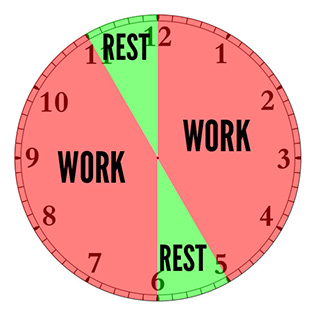In the studio today, Adrian introduce a writing technique called the Pomodoro technique. The Pomodoro technique is where you put all your concentration into a writing piece for a total of 25 minutes and then you take a five minute break. After a 25 minute of what I would call an intense period of writing, I discovered this writing technique is indeed useful. I will be using this technique for the during of my studies at RMIT.
I wrote these paragraphs in class today as part of the the script that will accompany my short film:
‘Since I’m one of the Queer Officers in the Queer Department for the RMIT University Student Union (RUSU), I plan to use my final media product as a means to promote not only the department that I am in charge of but also to promote a sense of belonging and worthiness in the safe space that the Queer Lounge at the RMIT city campus provides. This safe place that queer students have on a campus in a city that’s vibrant as Melbourne is privilege. A privilege that some queer students take for granted such as when they drink their morning coffee or eat their evening meal, they leave rubbish and their dirty dishes in the kitchen sink, to my dismay, for I am the one who has to clean up after them. There are various posters about cleaning up in the lounge, nonetheless these are to be ignored. The students must have such a busy schedule that they were able to exploit the property of RUSU, yet be lazy enough to wash their dishes.
Fluid as it is, sexuality and gender identity implores the notion that visibility is vulnerability, that is being visible as a queer individual in society is to be vulnerable, as there is a likelihood that they are can be more vulnerable to hate crimes, discrimination, and homophobic quips, especially so if they are an effeminate gay man, a butch lesbian or transgendered person.
By referencing a quote in Claire Colebrook’s article Queer Aesthetics:
‘Would it be possible to assert simply that one is: that I am the being who I am and have always been; that I do not expect or hope to change? Or, would it be possible—this time not referring to oneself—to a world or nature that is fully actualized and that bears neither a potentiality for change nor a tendency to change in ways that are not determined in advance by some norm?’ (pp. 26).
I will be exploring the various aspects of sexual orientation and gender identity, the challenges of coming out and determining the role in which society plays in the wellbeing of a queer individual in my final essay and in final work for this course. I aim to raise awareness and the plight of LGBT+ individuals and allow my audience to see a new perspective of what it means to identify as a queer individual.
I really like the part of the quote where it says ‘I am the being who I am and have always been; that I do not expect or hope to change?’. I would like to explore this short, little snippet rather that the entire quote. The entire quote itself to me seems quote complex, there are many parts to the quote that I feel will need addressing and I believe that in simplifying this quote, that’s a higher chance that I will be able to focus on sexual orientation and gender identity, or at least I hope.
Honestly, I have written more than a thousand words based on this snippet of the entire quote over the weekend, in my one of my blog posts recently, I noted that I plan to focus on various topics of the queer identity and queer issues such as coming out, religion, mental health, etc. I have followed through and as of now my essay is all over the place since there are random paragraphs in relations to the topics. Obviously, there will be a dire need to research to back up my essay.
Speaking of research, I came by this word a couple of days ago, this word is ‘sissyphobia’ and the definition of the word is something along the line of a person – most likely a cis-gendered masculine male – who is afraid or have a distinct dislike or even hatred of the more feminine male, that is, the effeminate gay man. Similar to homophobia, where homophobes do not agree on the life that queers lead, sissyphobia is where gay men dislike being with the more feminine man. What intrigued me was that this term is totally new to me, to be frank, I didn’t even know this word existed, but then again, there are plenty of words out there that I don’t know of that I know exist. I found four peer-reviewed articles on this term ‘sissyphobia’. So far, I only read the abstract of each article and even so, I found it quite informative and I plan to use one or more of these articles in my essay.
I’m intrigued by the idea that some gay masculine men view effeminate gay men as submissive and “weak”, why is there this creation of inequality? Is it even possible for effeminate gay men to be as equal as their more masculine peers, both inside the bedroom and out?
In the LGBT+ community there are many, many terms in describing each queer person. Many people have told me how they dislike this idea in being categorise, it makes them feel like cattle, one of those animals that you need to have this clear description of them in order to understand them, that their being, their representation of who are they as a person is undermine in other queer person’s view of them. Often they identify as non-binary, which is fair enough, since this world we live is so patriarchal, misogynic and discriminative of those who are not unlike them.
In the gay community, just like in the lesbian community, there are many terms in describing a gay man’s physical appearance, their personality and their mannerism – such “bears” and “twinks”. In the lesbian world, these opposites are clearly defined by “butches” and “femmes”.
I would like to explore the notion of mannerism. In reading one of the abstract of the sissyphobia articles, I’ve made the realisation that mannerism can be a topic that I am able to explore. For example, why is it that butch lesbians are categorise as a masculine with male traits and why are femme lesbian categorise as feminine with female traits: even though femme lesbians identify as cis-gendered females – though there are some males to females (MTF) transgendered people that identify as femme lesbians.
Mannerism is what make the queer community go round, I for one, believe this to be true, in my three years of coming to terms with myself, it appears that it all comes down to mannerisms, that’s what people in your community would classify you as. It’s rather sad actually, as if you are nothing more than a label. Yes, labels! Why is it that in the queer community we like to label each other? Yet, heterosexuals label us? Why do we do it to each other? The notion of stereotypes in the queer community is rife.
In one of the articles about sissyphobia, the author noted that some gay masculine men dislike men with feminine characteristics because they feel threatened by them, that it is through their own insecurity of effeminate gay men, even of gay dating/hook up mobile applications such as Grindlr.’


